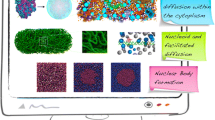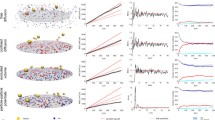Abstract
In this paper, we present the Cellular Dynamic Simulator (CDS) for simulating diffusion and chemical reactions within crowded molecular environments. CDS is based on a novel event driven algorithm specifically designed for precise calculation of the timing of collisions, reactions and other events for each individual molecule in the environment. Generic mesh based compartments allow the creation / importation of very simple or detailed cellular structures that exist in a 3D environment. Multiple levels of compartments and static obstacles can be used to create a dense environment to mimic cellular boundaries and the intracellular space. The CDS algorithm takes into account volume exclusion and molecular crowding that may impact signaling cascades in small sub-cellular compartments such as dendritic spines. With the CDS, we can simulate simple enzyme reactions; aggregation, channel transport, as well as highly complicated chemical reaction networks of both freely diffusing and membrane bound multi-protein complexes. Components of the CDS are generally defined such that the simulator can be applied to a wide range of environments in terms of scale and level of detail. Through an initialization GUI, a simple simulation environment can be created and populated within minutes yet is powerful enough to design complex 3D cellular architecture. The initialization tool allows visual confirmation of the environment construction prior to execution by the simulator. This paper describes the CDS algorithm, design implementation, and provides an overview of the types of features available and the utility of those features are highlighted in demonstrations.










Similar content being viewed by others
References
Andrews, S. S., & Bray, D. (2004). Stochastic simulation of chemical reactions with spatial resolution and single molecule detail. Physical Biology, 1, 137–151.
Boulianne, L., Al Assaad, S., Dumontier, M., & Gross, W. J. (2008). GridCell: a stochastic particle-based biological system simulator. BMC Systems Biology, 2, 66.
Bower, J. M., & Beeman, D. (eds) (1998). The book of GENESIS: Exploring Realistic Neural Models with the General Purpose Neural Simulation System. Springer-Verlag, New York (second edition).
Bredt, D. S., & Nicoll, R. A. (2003). AMPA receptor trafficking at excitatory synapses. Neuron, 40(2), 361–379.
Carslaw, H. S., & Jaeger, J. C. (1986). Conduction of heat in solids (2nd ed.). New York: Oxford University Press.
Dix, J. A., & Verkman, A. S. (2008). Crowding effects on diffusion in solutions and cells. Annual Review Biophysics, 37, 247–263.
Donev, A., Torquato, S., & Stillinger, F. H. (2005). Neighbor list collision-driven molecular dynamics simulation for non-spherical hard particles. I. Algorithmic details. Journal of Computational Physics, 202, 737–764.
Erban, R., & Chapman, S. J. (2009). Stochastic modelling of reaction-diffusion processes: algorithms for bimolecular reactions. Physical Biology, 6(4), 46001.
Fauerby, K. (2003). Improved collision detection and response. http://www.peroxide.dk/.
Fiala, J. C., & Harris, K. M. (2001). Extending unbiased stereology of brain ultrastructure to three-dimensional volumes. Journal of the American Medical Informatics Association, 8(1), 1–16.
Gillespie, D. T. (1976). A general method for numerically simulating the stochastic time evolution of coupled chemical reactions. Journal of Computational Physics, 22, 403–434.
Groc, L., & Choquet, D. (2006). AMPA and NMDA glutamate receptor trafficking: multiple roads for reaching and leaving the synapse. Cell and Tissue Research, 326(2), 423–438.
Hattne, J., Fange, D., & Elf, J. (2005). Stochastic reaction-diffusion simulation with MesoRD. Bioinformatics, 21(12), 2923–2924.
Hugel, S., Abegg, M., Paola, V., Caroni, P., Gahwiler, B. H., & McKinney, R. A. (2008). Dendritic spine morphology determines membrane-associated protein exchange between dendritic shafts and spine heads. Cerebral Cortex, 19(3), 697–702.
Hwang, C.-O., Given, J. A., & Mascagni, M. (2001). The simulation-tabulation method for classical diffusion Monte Carlo. Journal of Computational Physics, 174(2), 925–946.
Kerr, R. A., Bartol, T. M., Kaminsky, B., Dittrich, M., Chang, J.-C. J., Baden, S. B., et al. (2008). Fast Monte Carlo simulation methods for biological reaction-diffusion systems in solution and on surfaces. SIAM Journal on Scientific Computing, 30(6), 3126–3149.
Kim, H., & Shin, K. J. (1999). Exact solution of the reversible diffusion-influenced reaction for an isolated pair in three dimensions. Physical Review Letters, 82(7), 1578–1581.
Klein, G. (1952). Mean first-passage times of Brownian motion and related problems. Proceedings of the Royal Society of London. Series A. Mathematical and Physical Sciences, 211(1106), 431–443.
Kubota, Y., Putkey, J. A., Shouval, H. Z., & Waxham, M. N. (2008). IQ-motif proteins influence intracellular free Ca2+ in hippocampal neurons through their interactions with Calmodulin. Journal of Neurophysiology, 99, 264–276.
Moraru, I. I., Schaff, J. C., Slepchenko, B. M., Blinov, M. L., Morgan, F., Lakshminarayana, A., et al. (2008). Virtual cell modelling and simulation software environment. IET Systems Biology, 2(5), 352–362.
Muller, M. E. (1956). Some continuous Monte Carlo methods for the Dirichlet problem. Annals of Mathematical Statistics, 27(3), 569–589.
Opplestrup, T., Bulatov, V. V., Gilmer, G. H., Kalos, M. H., & Sadigh, B. (2006). First-passage Monte Carlo algorithm: diffusion without all the hops. Physical Review Letters, 97(23), 230602.
Redner, S. (2001). A guide to first passage processes. New York: Cambridge University Press.
Ridgway, D., Broderick, G., Lopez-Campistrous, A., Ru’aini, M., Winter, P., Hamilton, M., et al. (2008). Coarse-grained molecular simulation of diffusion and reaction kinetics in a crowded virtual cytoplasm. Biophysical Journal, 94(10), 3748–3759.
Santamaria, F., Wils, S., De Schutter, E., & Augustine, G. J. (2006). Anomalous diffusion in Purkinje cell dendrites caused by spines. Neuron, 52(4), 635–648.
Sigurgeirsson, H., Stuart, A., & Wan, W.-L. (2001). Algorithms for particle-field simulations with collisions. Journal of Computational Physics, 172, 766–807.
Sutherland, W. (1905). A dynamical theory of diffusion for non-electrolytes and the molecular mass of albumin. Philosophical Magazine, 9, 781–785.
Stiles, J. R., Van Helden, D., Bartol, T. M., Jr., Salpeter, E. E., & Salpeter, M. M. (1996). Miniature endplate current rise times less than 100 microseconds from improved dual recordings can be modeled with passive acetylcholine diffusion from a synaptic vesicle. Proceedings of the National Academy of Sciences of the United States of America, 93(12), 5747–5752.
Wils, S., & De Schutter, E. (2009). STEPS: modeling and simulating complex reaction-diffusion systems with Phyton. Frontiers in Neuroinformatics, 3(15), 1–8.
van Zon, J. S., & ten Wolde, P. R. (2005). Green’s function reaction dynamics: a particle-based approach for simulating biochemical networks in time and space. Journal of Chemical Physics, 123(23), 234910–234916.
Acknowledgments
This work was supported by U.S. National Institutes of Health grant NS038310. We would like to thank Pete Swulius and Dave Howard for their invaluable help on developing an early version of the visualization tool.
Author information
Authors and Affiliations
Corresponding author
Rights and permissions
About this article
Cite this article
Byrne, M.J., Waxham, M.N. & Kubota, Y. Cellular Dynamic Simulator: An Event Driven Molecular Simulation Environment for Cellular Physiology. Neuroinform 8, 63–82 (2010). https://doi.org/10.1007/s12021-010-9066-x
Published:
Issue Date:
DOI: https://doi.org/10.1007/s12021-010-9066-x




